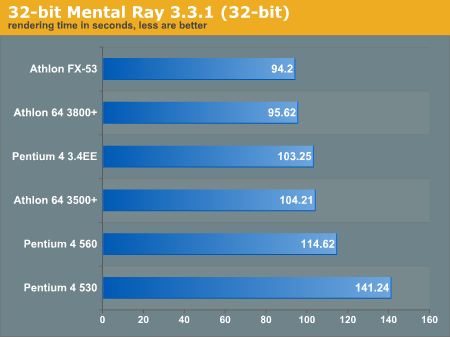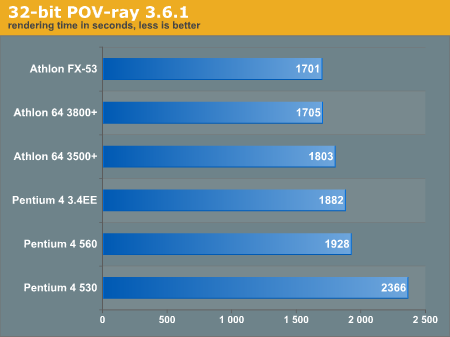Linux Desktop CPU Roundup: Cutting Edge Penguin Performance
by Kristopher Kubicki on September 19, 2004 8:00 PM EST- Posted in
- Linux
Rendering Benchmarks
Below, we use Mental Ray 3.3.1 to render a particularly intensive benchmark scene (which you can download here). Maya exists in 64-bit binaries in various circles, but we have only been able to obtain a 32-bit license and thus a 32-bit version of MentalRay. Below, you can see how the 32-bit binaries perform on both 64-bit and 32-bit versions of SuSE 9.1 Pro.The P4EE receives a large bonus with the L3 cache with MentalRay, although that only slates it even with our Athlon 64 3500+. Although floating point operations generally govern the behavior of rendering time, memory plays a considerable role as well; the on chip memory controller for the AMD chips show their true colors here. Below, you can see how the various processors perform under the ray tracing program POV-Ray.
POV-Ray shows almost identical scaling to the MentalRay benchmark. We also noticing a trend between the Athlon 3800+ and the Athlon FX-53. Even though they have 512KB difference in cache, many of our benchmarks aren't showing that the processor utilizes that additional cache to its advantage. There are enormous performance benifits by under 64-bit operation with POV-Ray.












33 Comments
View All Comments
ravedave - Monday, September 20, 2004 - link
What klah is trying to say in too many and too big of words : Make the scale the same for the mouseover pics.Also make the picture height the same as well if possible.
Otherwise a very good article.
Has anyone thought of making an open office benchmark for linux?
klah - Monday, September 20, 2004 - link
Good article, but I have a comment on the mouse-over graphs. They work well in other articles such as the recent DVR-108D article where the scale and axes remain constant. In this case however the layout and in some cases even the scale are different between the two graphs. It would be easier to compare the two if the scale was the same and processors were in the same layout(spacing/location), with the inapplicable processors still listed to maintain the same appearance between the two.If that explanation is nonsensical I can create a few images to try to elucidate my point.
Decoder - Monday, September 20, 2004 - link
"Hold your mouse over for the 64-bit graph."I like to see the 32 and 64 bits on the same graph. Why not use Athlon FX-53 (32) and Athlon FX-53 (64) for labels?